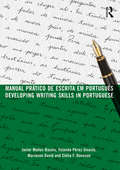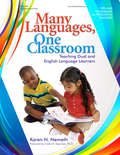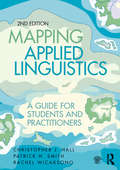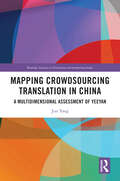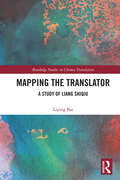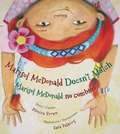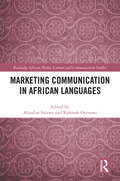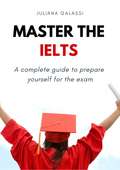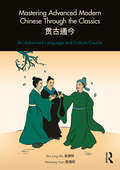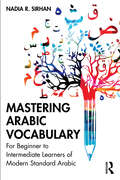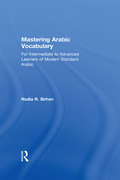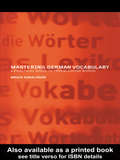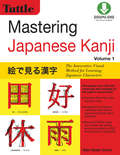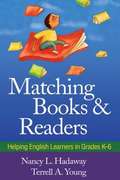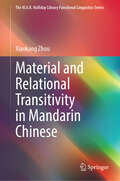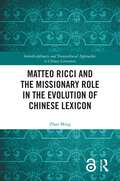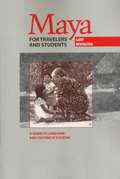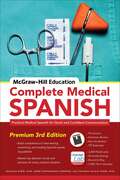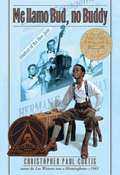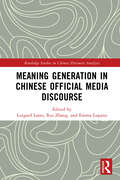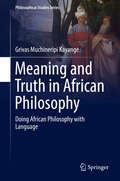- Table View
- List View
Manual prático de escrita em português: Developing Writing Skills in Portuguese (Developing Writing Skills)
by Javier Muñoz-Basols Marianne David Yolanda Pérez Sinusía Clélia F. DonovanManual prático de escrita em português/Developing Writing Skills in Portuguese provides intermediate- and advanced-level students with the necessary skills to become competent and confident writers in the Portuguese language. With a focus on writing as a craft, Manual prático de escrita em português offers a rich selection of original materials including narrative texts, expository essays, opinion pieces and newspaper articles. Each chapter covers a specific kind of writing and is designed to help tackle the material in small units. The book aids students in crafting clear, coherent and cohesive texts by means of guided practice and step-by-step activities. Suitable for use as a classroom text or as a self-study course, this book is ideal for students at level B2 – C2 of the Common European Framework for Languages or at Intermediate High – Advanced High on the ACTFL proficiency scales.
Many Languages, One Classroom: Teaching Dual and English Language Learners
by Karen NemethIn classrooms across the country, teachers are encountering more children who are learning English, come from diverse backgrounds, and who speak a variety of languages. As challenging as this may be, a preschool teacher's goal remains the same: to welcome all children and give them the best possible start in education and in life. Even the most experienced teacher can feel a bit unsure about meeting the unique needs of children from different language backgrounds. Many Languages, One Classroom applies the latest information about best practices to all aspects of a preschool program. From using lists of key words and visual aids to using body language and gestures, the strategies you will find in this book are adaptable and easy to put into practice. Designed to fit any preschool curriculum, Many Languages, One Classroom addresses state standards and benchmarks of standard quality programming. Organized by interest areas and times of the day, you'll find everything you need to help English language learners during dramatic play, outdoor play, reading, science, blocks, and circle time.
Mapping Applied Linguistics: A Guide for Students and Practitioners
by Christopher J. Hall Rachel Wicaksono Patrick H. SmithMapping Applied Linguistics: A guide for students and practitioners, second edition, provides a newly updated, wide-ranging introduction to the full scope of applied linguistics. This innovative book maps the diverse and constantly expanding range of theories, methods and issues faced by students and practitioners around the world, integrating both sociocultural and cognitive perspectives. Practically oriented and ideally suited to students new to the discipline, Mapping Applied Linguistics provides in-depth coverage of: multilingualism, language variation and Global Englishes literacy, language teaching and bilingual education discourse analysis language policy and planning lexicography and translation language pathology and forensic linguistics The new second edition features contemporary examples of global applied linguistics research and practice, and includes updated further reading and new fieldwork suggestions for each chapter. The companion website at cw.routledge.com/textbooks/hall provides a wealth of additional learning material, including activities, flashcards and links to the latest online resources. Mapping Applied Linguistics is essential reading for students studying applied linguistics, TESOL, general linguistics and language and literacy education at the advanced undergraduate or master’s degree level. It also provides a gateway for practitioners and specialists seeking to better understand the wider scope of their work.
Mapping Crowdsourcing Translation in China: A Multidimensional Assessment of Yeeyan (Routledge Advances in Translation and Interpreting Studies)
by Jun YangYang explores the use of crowdsourcing in translation within the Chinese context, focusing on Yeeyan – the largest online translation community in China. As one of the world’s largest markets for language content consumption, China experiences significant demand for translation services. Yeeyan, a pioneer among amateur translation communities in China, offers an autonomous environment where the public collectively determines the content they wish to import from foreign languages.The book conducts a holistic evaluation of crowdsourcing translation using a multidimensional analytical framework, emphasising the interrelations among agents, processes, products, and crowdsourcing environments. Using the Yeeyan community as a case study, the book investigates the motivations behind participation in Yeeyan, the quality of translations produced, the extent to which this quality can be controlled, and how learning occurs through their participation. The analysis includes the two primary types of projects facilitated by Yeeyan – article translation for knowledge-sharing and book translation for commercial publication. Additionally, Yang explores the emerging field of crisis translation - assessing the applications of crowdsourcing in disaster contexts and exploring the ethical implications involved. Drawing on empirically informed results, the book proposes recommendations for the effective design and organisation of crowdsourcing translation projects and elucidates how such initiatives can be optimally utilised in both translation production and translation training endeavours.This book is a valuable contribution to the field of translation studies, offering a detailed examination of crowdsourcing translations and the participatory culture of the Chinese internet.
Mapping the Translator: A Study of Liang Shiqiu (Routledge Studies in Chinese Translation)
by Liping BaiIn Mapping the Translator: A Study of Liang Shiqiu, the writer studies Liang Shiqiu (1903–1987), who was not only a famous writer and important critic but also one of the most prominent translators in China in the 20th century, most notably the first Chinese to finish a translation of The Complete Works of William Shakespeare. Based on primary sources, this research covers issues related to the historical, cultural, cognitive and sociological dimensions of translator studies. It investigates Liang’s translation poetics; the influences of possible patrons and professionals on him; the relationship between Liang’s ideology, the dominant ideology and his translation; Liang’s debates with Lu Xun about and beyond translation criteria, and whether there is inconsistency or possible contradiction in Liang’s translation poetics. This book also analyses the similarities and differences between Liang Shiqiu and Wu Mi–two followers of Irving Babbitt–in terms of translation poetics, and further explores the reasons leading to such differences. This book is targeted at scholars and students, both undergraduate and postgraduate, in the fields of translation studies, Asian studies, Chinese studies, and literary studies.
Marisol McDonald Doesn't Match: Marisol Mcdonald No Combina (Marisol Mcdonald)
by Monica BrownA creative, unique, bilingual, Peruvian-Scottish-American-soccer-playing artist celebrates her individuality.
Marketing Communication in African Languages (Routledge African Media, Culture and Communication Studies)
by Abiodun Salawu Kehinde OyesomiThis edited volume considers the use of African languages for marketing communication. The importance of an indigenous language stems from its benefits, which include increased comprehension and a sense of resonance among the target audience, which makes it more memorable as opposed to foreign languages.Chapters in the book variously examine African traditional advertising and marketing; popular culture as a channel for advertising and marketing; political communication, advertising and marketing; commercials and public relations in African languages; as well as branding, corporate and public communication in African languages. The use of African languages for marketing communication is considered on the traditional mass media and the digital media. Readers will gain a lot of insights into the theory and practice of marketing communication in African languages.
Master the IELTS: A complete guide to prepare yourself for the exam
by Juliana GalassiDo you need to take the IELTS to secure your spot in a foreign exchange program, but have no idea where to begin? With this Master the IELTS guide, you will learn a practical and effective method to prepare yourself for the exam, without interrupting your normal routine. It doesn't matter if you have little time before the test or if you aren't at an advanced English level. With this guide you will understand everything about the exam, the right way to prepare, how to know your real English level, and, on top of that, you will have access to various materials to complement your studies. You will also learn how to put together a study schedule that fits into your routine, learn the most common mistakes made by IELTS test takers and how to avoid them, and have access to more than 70 practice tests. Access this Master the IELTS ebook and attain the score you need!
Mastering Advanced Modern Chinese through the Classics: An Advanced Language and Culture Course
by Shu-Ling Wu Haiwang Yuan<p>Mastering Advanced Modern Chinese through the Classics is a textbook to teach those who wish to achieve an advanced or native proficiency and cultural competence in modern Chinese, as well as to experience the beauty of Classical Chinese literature. <p>Collecting representative works containing vibrant views of Chinese culture from different dynasties, this book is focused on how the grammatical patterns, vocabulary, and idioms that are found in Classical Chinese are relevant in the modern adaptation of the language, and how the accumulated traditional values and beliefs found there still shape the thinking and lifestyle of modern society. Online resources including audio, answer keys, and instructor aids will be part of the teaching package.</p>
Mastering Arabic Vocabulary: For Beginner to Intermediate Learners of Modern Standard Arabic
by Nadia R. SirhanMastering Arabic Vocabulary: For Beginner to Intermediate Learners of Modern Standard Arabic provides a structured vocabulary course for novice students of Arabic. Arranged thematically, and by root, the course is a flexible resource that can be used alongside other learning materials. The unique root organisation supports students’ understanding of the structure of Arabic words and of the connection between form and meaning in Arabic vocabulary. The wealth of exercises throughout are designed to reinforce learning and help students gain a solid foundation in the key vocabulary needed to reach an intermediate level. Mastering Arabic Vocabulary is the ideal reference for building a strong foundation in Arabic vocabulary, for students from beginner level up to B1-B2 CEFR and ACTFL Intermediate-Low to Intermediate-High.
Mastering Arabic Vocabulary: For Intermediate to Advanced Learners of Modern Standard Arabic
by Nadia R. SirhanMastering Arabic Vocabulary provides a structured vocabulary course for undergraduate and advanced students of Arabic. Arranged thematically, and by root, the course presents the key vocabulary that a well-informed Arabic speaker should have at their disposal when discussing diverse topics from business and politics to culture, society, science and technology. The course includes a wealth of exercises throughout to support learners from passive recognition to an increase in their active vocabulary. With free MP3s available online to allow learners to familiarise themselves with the pronunciation of each word provided in the book, Mastering Arabic Vocabulary is the ideal reference source for students of Arabic to build and expand their vocabulary.
Mastering German Vocabulary: A Practical Guide to Troublesome Words
by Bruce DonaldsonHow often have you looked up an English word in a German dictionary only to be confronted by a bewildering array of German equivalents? Which is the correct word for the context in question? Thirty years' experience in teaching Germanic languages at tertiary level to English-speaking students have made the author acutely aware of this problem. Mastering German Vocabulary explains how to use over 2,200 common German words correctly, using example sentences in German with English translations.In order to aid quick consultation, all German and English words are listed in separate indexes. The book is designed for all upper secondary and tertiary students of German and complements Routledge's grammar, dictionary and vocabulary building textbooks. It is a practical companion for anyone serious about perfecting their German.
Mastering Japanese Kanji: The Innovative Visual Method for Learning Japanese Characters:1
by Glen Nolan GrantThis is a comprehensive, self-study workbook for learning Japanese characters.Mastering Japanese Kanji can help you greatly reduce the time and effort involved in learning to read Japanese and write Japanese.<P><P> It does so by introducing a method that is both effective and easy to use in memorizing the meanings and pronunciations of Kanji-the array of characters that are used in the Japanese language to symbolize everything from abstract ideas to concrete nouns.Learning any of the kanji is a two step process, requiring that you remember both the visual aspect of a character (so you can recognize it when you see it) and the aural aspect (so you will know how to say and, thus, read it). The method employed by Mastering Japanese Kanji will show you how to tackle both of these aspects from the outset, and by so doing enable you to immediately get down to the practical (and fun!) business of recognizing and reading kanji on everything from street signs to newspapers. By the time you finish this book, in fact you will be able to boast of a Japanese vocabulary numbering in the thousands of words.Key features: Downloadable material helps to reinforce the written materialTeaches the 200 most common kanji and the hundreds of compounds that use include them. Unique, specially-designed drawings and entertaining stories help you learn more quickly. Sample sentences, along with common words and compounds, expand your vocabulary by showing each kanji used in context. Stroke-order diagrams show the correct way to write each chapter. Chapter and cumulative review exercises help ensure master of what you've learned. Complete indexes show Japanese readings and English meanings for all Kanji.
Matching Books and Readers
by Nancy Hadaway Terrell YoungProviding practical guidance and resources, this book helps teachers harness the power of children's literature for developing ELLs' literacy skills and language proficiency. The authors show how carefully selected fiction, nonfiction, and poetry can support students' learning across the curriculum. Criteria and guiding questions are presented for matching books and readers based on text features, literacy and language proficiency, and student background knowledge and interests. Interspersed throughout are essays and poems by well-known children's authors that connect in a personal way with the themes explored in the chapters. The annotated bibliography features over 600 engaging, culturally relevant trade titles.
Material and Relational Transitivity in Mandarin Chinese (The M.A.K. Halliday Library Functional Linguistics Series)
by Xiaokang ZhouThis book presents a systemic-functional analysis of aspects of transitivity in Mandarin Chinese, focusing on two major types of clause: material clauses and relational clauses. Material clauses represent actions/events in the material world. Relational clauses express relationships between entities in the most general sense; they include as their prototypical members ‘being’ or ‘copula’ clauses. It demonstrates a brief account of the theoretical framework of SFG. The book also provides a detailed description of material clauses, to deal in turn with three major types of relational clause: attributive, locational, and possessive. One of the significant findings of the monograph is that relational clauses encompass a much larger portion of the grammar than is usually believed and include various ‘processes’ such as ‘giving’, ‘renting’, ‘putting’, in addition to ‘being’ (usually classified as material). Hence, the notion of transitivity has been refined.
Matteo Ricci and the Missionary Role in the Evolution of Chinese Lexicon (Interdisciplinary and Transcultural Approaches to Chinese Literature)
by Zhao MingThis is a systematic study of Matteo Ricci’s (1552–610) enormous impact on the development of modern scientific and intellectual terminology in China.Taking the Sino‑estern cultural exchanges initiated by Western Jesuit missionaries in the late‑ing dynasty as its starting point, this book comprehensively presents the new terms coined by Ricci (and his collaborators) in his religious, geographical, geometrical, and astronomical Chinese writings. It uses a multitude of examples adopted from Ricci’s Chinese works as well as from ancient Chinese documents to discuss etymological evolution. Ricci’s early coinages of terms and their subsequent history demonstrate the role of interaction and scholarly collaboration between the late Ming Jesuits and Chinese intellectuals in the formation of modern Chinese lexicon. The research conclusions of this book will further advance Ming‑ynasty studies and contribute to a new understanding of the creation of modern Chinese lexicon.This book is a vital resource for students, scholars, and linguists studying and researching in the history of Chinese and early Mandarin. This volume will also be very interesting among students and scholars of Chinese literature and history, particularly among scholars who work in Ming history and literature.The Open Access version of this book, available at www.taylorfrancis.com, has been made available under a Creative Commons Attribution-Non Commercial-No Derivatives (CC-BY-NC-ND) 4.0 International license
Maya for Travelers and Students: A Guide to Language and Culture in Yucatan
by Gary BevingtonThe Yucatan Peninsula draws many North American and European travelers each year to view the ruins of the pre-Columbian Classical Maya civilization and the abundant native flora and fauna. For these travelers, as well as armchair travelers and students, Gary Bevington has prepared the first general English-language introduction to Yucatec Maya, the native language of the people indigenous to the region. Written in nontechnical terms for learners who have a basic knowledge of simple Mexican Spanish, the book presents easily understood, practical information for anyone who would like to communicate with the Maya in their native language. In addition to covering the pronunciation and grammar of Maya, Bevington includes invaluable tips on learning indigenous languages "in the field. " Most helpful are his discussions of the cultural and material worlds of the Maya, accompanied by essential words and expressions for common objects and experiences. A Maya-English-Spanish glossary with extensive usage examples and an English-Maya glossary conclude the book. Note: The supplemental audiocasette, Spoken Maya for Travelers and Students, is now available as a free download.
McDougal Littell Discovering French Nouveau!, Blanc 2, Workbook (Discovering French, Nouveau!)
by Jean-Paul Valette Rebecca M. ValetteNIMAC-sourced textbook
McDougal Littell Discovering French Nouveau!, Bleu 1, Workbook
by Jean-Paul Valette Rebecca M. ValetteNIMAC-sourced textbook
Mcgraw-hill Education Complete Medical Spanish, Third Edition: Practical Medical Spanish For Quick And Confident Communication
by Joanna Rios José Fernández Torres Tamara RíosMcGraw-Hill Complete Medical Spanish, Third Edition helps you communicate effectively with Spanish-speaking patients and improve the quality of the medical care they receive. Each chapter of this bestselling program features vocabulary, key phrases, dialogs based on common medical situations, and exercises that reinforce understanding and build confidence. No prior knowledge of Spanish is necessary. Start now and in no time you'll fluently interview patients, conduct exams, and provide follow-up instructions.
Me llamo Bud no Buddy
by Christopher Paul Curtis Alberto Jiménez RiojaBud no quiere regresar al orfanato después de su desastrosa noche en la casa de los Amós; por lo tanto, decide ir en busca del líder de la banda que él cree que es el padre que nunca ha conocido. Los lectores encontrarán irresistible esta conmovedora historia de la época de la Depresión.
Meaning Generation in Chinese Official Media Discourse (Routledge Studies in Chinese Discourse Analysis)
by Rui Zhang Lutgard Lams Emma LupanoDrawing on approaches from Linguistic Pragmatics, Critical Discourse Analysis, Conceptual Metaphor Theory, Social Actor Representation Theory, and Framing Theory, this book critically explores the various linguistic devices and pragmatic strategies that concern meaning generation in the context of Chinese official media discourse.The volume rests on eight chapters that—using different analytical lenses, with either a culture-specific perspective or a cross-cultural one—take language analysis as their point of departure, in order to investigate how meaning is generated in situated discourse, such as media accounts about specific issues within the socio-political, cultural, or economic sphere. Each chapter is empirically grounded, and either focuses on a specific genre, such as the documentary and the press conference, or explores social and political events and initiatives that have been topical in recent years: the Covid-19 and SARS crises, the US-China trade conflict, the Regional Comprehensive Economic Partnership (RCEP), and the 2021 Hong Kong electoral system reform.By bringing back the linguistic analysis to the core of the analytical approach, the volume shows the interconnection of text and context, reminding the reader about the key role of language users both on the production and reception side.This book will be of interest to students and scholars interested in the relation between language and politics and, in particular, in understanding meaning-making and meaning-moulding processes in discourses articulated in an official Chinese context aimed both internally and internationally.
Meaning and Truth in African Philosophy: Doing African Philosophy with Language (Philosophical Studies Series #135)
by Grivas Muchineripi KayangeThis book offers a new way of doing African philosophy by building on an analysis of the way people talk. The author bases his investigation on the belief that traditional African philosophy is hidden in expressions used in ordinary language. As a result, he argues that people are engaging in a philosophical activity when they use expressions such as taboos, proverbs, idioms, riddles, and metaphors. The analysis investigates proverbs using the ordinary language approach and Speech Act theory. Next, the author looks at taboos using counterfactual logic, which studies the meaning of taboo expressions by departing from a consideration of their structure and use. He argues that the study of these figurative expressions using the counterfactual framework offers a particular understanding of African philosophy and belief systems. The study also investigates issues of meaning and rationality departing from a study on riddles, explores conceptual metaphors used in conceptualizing the notion of politics in modern African political thought, and examines language and marginalization of women and people with disabilities. The book differs from other works in African philosophy in the sense that it does not claim that Africans have a philosophy as is commonly done in most studies. Rather, it reflects and unfolds philosophical elements in ordinary language use. The book also builds African Conception of beauty and truth through the study of language.
Measurement and Evaluation in Post-Secondary ESL
by Glayol V. EkbataniPractical and concise, this introductory text for language teaching professionals is a guide to ESL assessment and to fulfilling the testing component of TESOL programs in the U.S. and around the world. Covering the fundamental descriptive and quantitative facets of effective language testing, it explicates key technical aspects in an accessible, non-technical manner. Each chapter includes relevant practical examples and is augmented by a partnered project that provides practical opportunities for readers to apply the concepts presented in real testing situations. Measurement and Evaluation in Post-Secondary ESL: Discusses effective methods of evaluating the language proficiency of college-bound English language learners in various skills areas such as reading, oral proficiency, and writing Takes a fresh look at accepted assessment concepts and issues such as validity and reliability, construct definition, authenticity, washback, reliable scoring, rater training, holistic and analytic rubrics, standardized tests, and statistical concepts Places special emphasis on innovative methods and alternative forms of assessment, such as self and portfolio assessment, as an adjunct to traditional methods Reviews the changes in the new internet-based Test of English a Second Language launched in 2005 Addresses the role and responsibilities of assessors
Media Arabic: Journalistic Discourse for Advanced Students of Arabic
by Jonas ElboustyMedia Arabic provides advanced students of Arabic with a range of engaging texts on controversial and contemporary topics that reflect the current social and political environment in the Middle East. Divided into ten thematic modules, each module includes three units based on a selection of authentic newspaper articles that dive deep into topics as diverse as climate change, racism, and corruption. Each unit contains comprehension and discussion questions as well as vocabulary lists, translation exercises, and creative writing exercises. Each topic also benefits from a curated selection of authentic news videos, which can be accessed at www.routledge.com/9781032044460. Ideal for use in Media Arabic courses, this book can also be used as a self-study resource for advanced level students.
